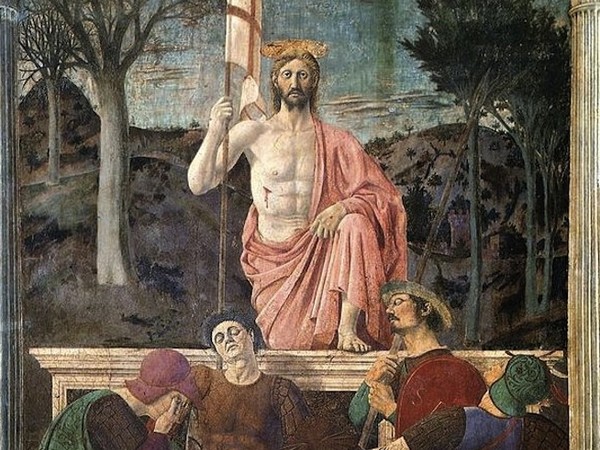 |
| Picture: Arte.it |
Disturbing news from Italy that Piero della Francesca's fresco of The Resurrection is to be 'restored' (link in Italian, via Maaike Dirkx). Recent record of fresco restoration in Italy has been horrific. Michelangelo's Sistine Chapel ceiling and Masaccio's frescoes in the Brancacci Chapel have both been hideously botched. True fresco painting applies pigment to wet plaster, which absorbs the pigment. But fresco painting didn't stop there; details were painted on after the plaster dried, called a secco. These details have often scrubbed and scoured by insensitive recent restorations. It's tragic that so much damage has been done so recently to major works of art that had survived centuries of benign neglect.
I saw this great Piero recently in Sansepolcro. It didn't strike me that it needed any restoration. But conservators want the prestige of working on the most important works of art, rather than those that actually need conserving. So great artworks are hacked about again and again, whilst lesser works crumble for want of attention. Money is desperately needed to conserve Pompeii, and to improve access to thousands of lesser attractions in Italy. The restoration of the Piero is being sponsored by an un-named individual. The fashion for sponsoring restorations is tawdry. Some galleries have a credit line against almost every other picture to identify to sponsor of the restoration. I worry that it incentivises the conservators to make pictures look as different as possible to show the sponsors how much effect they've had.
In finance the phrase 'this time is different' is used derisively against those who imagine that the latest bubble will end happily, unlike every bubble that has gone before. There is something similar in the world of art restoration. It is freely admitted that previous restorations were disastrous, but we are always assured that the next one will be different, because we are so much wiser. The truly wise course of action was recommended in the fifth century BC: first, do no harm. Please leave the Piero alone.
Bravo - good to have you back!
ReplyDeleteThe comparison with Pompeii is well-made. I went to Herculaneum last summer and it was in a truly sorry state (so too the fresco rooms in the Museo Archeologico Nazionale di Napoli). The British Museum exhibition last year should have been a source of severe embarrassment for the Italian authorities for whom that quality of presentation should be easily achievable all year round.
Thanks - yes, Pompeii is only the best-known example. Many of the wonderful smaller museums in Italy are also in a parlous state. Yet still they spend money on restorations that are worse than unnecessary.
DeleteSomeone should sponsor the conservation of the Villa Borghese air conditioning, apparently it has been broken for two months and they are keeping windows open instead. http://www.telegraph.co.uk/news/worldnews/europe/italy/10823153/Priceless-paintings-threatened-by-Italian-gallerys-broken-air-con.html
ReplyDeleteThanks - yes, absolutely. That story came out just after I'd written this, and makes the point even better. The other awful thing about the Borghese is that you have to leave when your allocated time slot expires. Most of the tickets sell in advance to tour groups. Whole thing is dreadfully run!
DeleteI agree on Pompei,and the Borghese,but not on the Sistine chapel.The colour palette that Michelangelo used was light and colourful,as opposed to the later chiaroscuro;the same with Raphael.And the rest of the manierists.If you take samples of what comes off with the first cotton swabs,I'm sure you can decide what is original and what isn't.Let alone what any cross section may reveal.For generations we are looking at a jaundiced Mona Lisa,before a poisonous green background,where it should be pink and blue.Soon these monuments will be put in a glass safe,with computer-generated copies next to them.
ReplyDelete